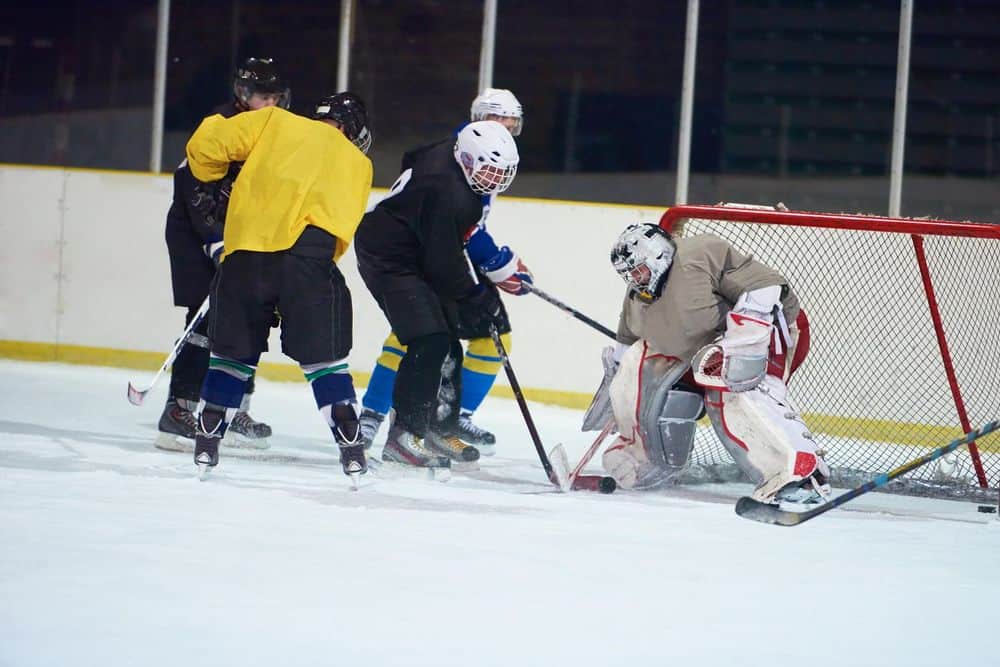In the dynamic realm of hockey, shots on goal (SOG) hold immense significance. These shots serve as a testament to a player’s ability to break through the opposing team’s defense, propelling the puck into the net and securing points for their team. However, the true power behind SOG extends far beyond its surface level.
Shots on goal encompass a wide array of shot types, ranging from high-quality scoring opportunities to less impactful attempts. Understanding the intricacies of SOG is crucial for players, coaches, and fans alike.
This article aims to unravel the mysteries surrounding shots on goal in hockey, exploring the criteria for a shot to be counted, the influence of shot quality versus quantity, and the role of game situations and goaltending prowess in generating SOG.
Furthermore, we will delve into the concept of shooting percentage, evaluating its significance at both an individual player and team level. By decoding the enigma of SOG, we can develop a deeper appreciation for the complexities of the game and the factors that contribute to success on the ice.
What Is SOG in Hockey
Shots on goal (SOG) in hockey represent a player’s attempt to score a goal by putting the puck into the net. This fundamental aspect of the game is influenced by shot selection and offensive strategies employed by players and teams.
Shot selection refers to the decisions made by players regarding when and where to take a shot. It involves assessing the positioning of defenders, the goaltender’s vulnerabilities, and the best angle or opportunity to score.
Offensive strategies play a crucial role in creating scoring opportunities and generating SOG. These strategies can include setting up plays, creating traffic in front of the net, and executing effective passing sequences to create open shooting lanes.
Criteria for Counting Shots on Goal
To accurately count shots on goal in hockey, specific criteria must be met for a shot to be considered as such. Counting shots accurately is crucial for understanding a team’s offensive performance and evaluating a player’s shooting ability. Differentiating high danger shots from low-quality shots can provide deeper insights into a team’s scoring opportunities and overall offensive effectiveness.
| Criteria for Counting Shots on Goal | ||
|---|---|---|
| The shot must be directed towards the net | The shot must be saved by the goalie or enter the net | Long shots from the red line count as shots on goal |
| Randomly firing the puck down the ice or banking it off the boards may not count as a shot | Shots on goal are awarded to the player who tipped the puck | Hitting the post does not count as a shot on goal unless the puck enters the net |
The Importance of Shot Quality
When analyzing offensive performance in hockey, it is essential to understand the significance of shot quality. Shot selection and scoring efficiency play a crucial role in determining a team’s offensive success. Here are four key points to consider:
- Shot selection: It is not just about the number of shots on goal, but also the quality of those shots. Teams that take high-percentage shots from high-danger areas have a better chance of scoring goals.
- Scoring efficiency: It is important to convert a higher percentage of shots into goals. Teams that have a higher shooting percentage are more likely to find the back of the net and create scoring opportunities.
- Shot placement: The accuracy and placement of shots can greatly impact scoring efficiency. Shots aimed at the corners of the net have a higher chance of beating the goaltender compared to shots aimed at the center of the net.
- Traffic in front of the net: Creating traffic in front of the net can disrupt the goalie’s vision and increase the chances of a deflection or rebound goal. Teams that effectively utilize screens and traffic in front of the net can generate more high-quality scoring opportunities.
Understanding the importance of shot quality allows teams to optimize their offensive strategies and increase their chances of scoring goals. By focusing on shot selection, scoring efficiency, shot placement, and creating traffic in front of the net, teams can enhance their offensive performance and ultimately improve their chances of winning games.
The Role of Goaltenders in Save Percentage
Goaltenders play a pivotal role in determining save percentage in hockey. Save percentage is a statistical measurement used to evaluate a goaltender’s performance, calculated by dividing the number of saves made by the total number of shots faced. It is an essential metric in analyzing a goaltender’s effectiveness in stopping shots and preventing goals.
A higher save percentage indicates a more successful goaltender in making saves and denying the opposition from scoring. Goaltenders with save percentages above 0.920 are considered to be elite. However, save percentage can vary depending on factors such as the quality of shots faced and team defense.
A strong goaltender can single-handedly elevate a team’s save percentage and provide a solid foundation for success. Therefore, analyzing save percentage allows us to understand the impact and importance of goaltenders in the game of hockey.
Understanding Shooting Percentages
In the realm of hockey analytics, a key aspect to consider is the understanding of shooting percentages. Shooting accuracy and the impact of shot location play crucial roles in evaluating a player or team’s offensive performance. Here are four important points to consider when analyzing shooting percentages:
- Shooting accuracy: Shooting percentage measures a player or team’s ability to convert shots into goals. It is calculated by dividing the number of goals scored by the number of shots on goal and multiplying by 100. A higher shooting percentage indicates better accuracy and efficiency.
- Impact of shot location: The location of a shot on goal greatly affects its likelihood of being scored. Shots taken from high-danger areas, such as the slot or the crease, have a higher probability of finding the back of the net compared to shots taken from low-quality areas, such as the perimeter. Analyzing shot location helps identify players or teams that consistently generate high-quality scoring opportunities.
- Individual vs. team perspective: Shooting percentage can be measured from both an individual player and team perspective. Evaluating shooting percentages at both levels provides insights into individual player performance and overall offensive effectiveness.
- Factors influencing shooting percentages: Several factors can influence shooting percentages, including power play opportunities, shot quality, and the skill of the opposing goaltender. Teams with better goaltenders may be more willing to sacrifice shots on goal in favor of higher-quality scoring chances.
Understanding shooting percentages is crucial for assessing offensive performance in hockey. By analyzing shooting accuracy and the impact of shot location, analysts can gain valuable insights into player and team effectiveness in converting shots into goals.
Beyond SOG: Factors Influencing Success in Hockey
Factors Influencing Success in Hockey extend beyond Shots on Goal (SOG). While SOG is a crucial metric in evaluating offensive performance, there are other factors that significantly impact game outcomes. A cost benefit analysis of playing hockey reveals that factors such as teamwork, strategic positioning, player skill, coaching tactics, and goaltending performance all contribute to a team’s success. These elements go beyond the number of shots taken and highlight the importance of a holistic approach to the game. To illustrate the various factors influencing success in hockey, the following table provides a comparison between shots on goal and other crucial elements:
| Factors Affecting Success in Hockey | Shots on Goal (SOG) |
|---|---|
| Teamwork | X |
| Strategic Positioning | X |
| Player Skill | X |
| Coaching Tactics | X |
| Goaltending Performance | X |
Frequently Asked Questions
How Does the Cost of Playing Hockey Vary Based on Location and Level of Play?
The cost of playing hockey can vary based on location and level of play. Expenses such as registration fees, ice time, equipment, travel, and coaching fees can range from $2,000 to $10,000 per year for a player participating in organized hockey.
What Are the Specific Responsibilities of a Utility Player in Hockey?
The specific responsibilities of a utility player in hockey include the ability to play both forward and defense positions as needed. They provide versatility to the team, seamlessly transitioning between offensive and defensive roles to support their teammates and contribute to the game’s success.
How Many Players Are on the Ice During NHL Overtime in the Regular Season and Playoffs?
In NHL overtime, both in the regular season and playoffs, each team plays with a reduced number of skaters on the ice. In the regular season, three skaters per team participate, while in the playoffs, five skaters per team compete.
Are There Any Additional Expenses That Players May Need to Consider When Participating in Organized Hockey?
When participating in organized hockey, players need to consider additional expenses such as registration fees, ice time, equipment, travel, coaching fees, specialized training, tournaments, and team fees. These financial considerations should be budgeted accordingly.
Can You Provide Examples of Factors That Can Influence a Goaltender’s Save Percentage Other Than the Quality of Shots Faced?
Factors that can influence a goaltender’s save percentage, aside from the quality of shots faced, include team defense, goaltender skill and technique, positioning, anticipation, rebound control, and the ability to make timely saves in critical moments of the game.
Conclusion
In conclusion, the power behind shots on goal in hockey extends beyond simply putting the puck in the net.
Understanding the criteria for counting shots, the impact of shot quality, and the role of goaltenders in save percentage are all crucial aspects of analyzing the effectiveness of SOG.
Additionally, shooting percentages provide valuable insights into individual player and team performance.
By unraveling these complexities, we gain a deeper understanding of the factors that contribute to success on the ice.









